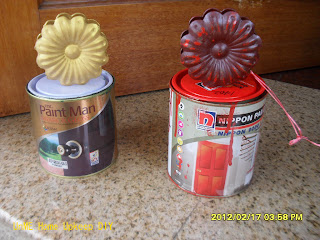 |
| Dull and faded wall with dirt stains |
The hot and humid weather plus plenty of rain in Malaysia accelerated the wear and tear to the exterior wall of building, fencing wall and floor. Fine crack lines appear on the plastered concrete column and brick wall. Fungus growth and the accumulated dirt stain turned the walls dull and ugly.
 |
| Remove flakes and stains using a pressure jet. |
This is the first time I repaint the fencing wall and column, after eight years. The thought of painting 165 feet by 5 feet of fencing wall scares me and deters me from doing this. I am also reluctant to engage a contractor. It costs too much. But after reading a motivational message from a friend, I was encouraged. Just set aside one to two hours a day for a specific task, many goals can be achieved. That spurs me to embark on this task. In order to avoid the hot sun, I spend one hour in the morning from seven to eight a.m. and one hour in the evening from five to six p.m. My wife and my son also joined in occasionally to help. The entire fencing wall was completely re-painted within a time frame of 16 days.
 |
| Stain on the column, below the crown. |
The original substrate was treated with ICI Dulux sealer and Anti-fungus Weathershield paint. This fencing wall started to fade after seven years. There wasn’t any fungus growth but some dirt accumulated beneath the shoulder overhung areas of the wall.
It is difficult to find a good and diligent painter who can produce good and durable paintwork. Most painting contractors engage low skill Indonesian painters and use cheap and low quality paint. Unless one is very specific in the negotiation, most painting contractors deliver a shoddy job.
 |
One side of the wall re-painted with three colours
|
 |
| Another side re-painted |
For lasting exterior paintwork, the substrate surface must be clean and dry before re-painting. Clean the surface thoroughly with a high pressure water jet. Allow a few days for the surface to dry. Plaster crack lines with sealant or grouting cement.
I contacted ICI Dulux and Nippon Paint for some technical assistance before commencing on this task.
ICI Dulux Weathershield is a water-based emulsion paint. There are other equivalent paints, but I have not tried them. Re-painting the wall with emulsion paint does not require lots of skills. Some common sense must prevailed to prevent spillage, staining and dripping. There is nothing to worry about paint stain. Simply wash off with water and soap before it dries. Stain can also be easily removed with a piece of damped cloth.
The paint should be diluted to the preferred viscosity that is smooth and not gummy to the roller and does not drip. Add about 20% of water to the can, stir thoroughly and gently with a stirrer to get an even mixture before applying.
Pour a small portion of the paint into the painting tray, Dip the paint roller into the paint and run over the tray a few times, until the paint is evenly distributed and absorbed by the roller but without any dripping. Then, gently apply the paint on the surface to be painted. A painter’s pole can be attached to the paint roller for areas beyond the reach of arm.
No matter how experienced a painter is, dripping of the paint cannot be avoided. Always place a large piece of plastic sheet or woven fabric of any kind to cover the floor. For any other areas, such as grilles, ornamental pieces, not to be in contact with the paint roller, insulate them with paper and masking tape.
Tools and material required:-
1. Emulsion paint for exterior surface. (Paint for interior surface is different), Weathershield comes in 5 liter tin only. One liter of paint can cover 110 sq. feet (10 sq. meters) of substrate with two coats.
2. Paint roller (two sizes: Big and small)
3. Painting tray
4. Painter’s pole
5. Stirrer
6. A pair of cotton hand gloves
7. A large plastic sheet or other woven fabric
8. A scrapper
9. A ladder or a stool.
10. A ½ brush
11. Some old newspapers.
 |
| The tools required for painting job. |
After each application, wash and dry the roller and tray with water thoroughly. No remnant of the paint should remain in the roller or tray. Otherwise, the roller and the tray will be rendered unusable once dried.
The ICI Dulux Weathershield of 5 liters cost RM115.00 (USD35.00) per can. A good paint roller cost RM5.00 (USD1.50) from the hardware shop. The painting tray is available at RM2.50 each. The price of painting brushes range between RM2.00 to RM3.50. The total cost of the materials used is less than RM500.00(USD152.00).
The painting contractor charge RM6,000.00 (USD1,818.00) for this job. Just see what you can save with DIY.
 |
| Three 5liter can of paint was used for the job. |
 |
| The fence wall has three-colour combination |









.jpg)

.jpg)
.jpg)

